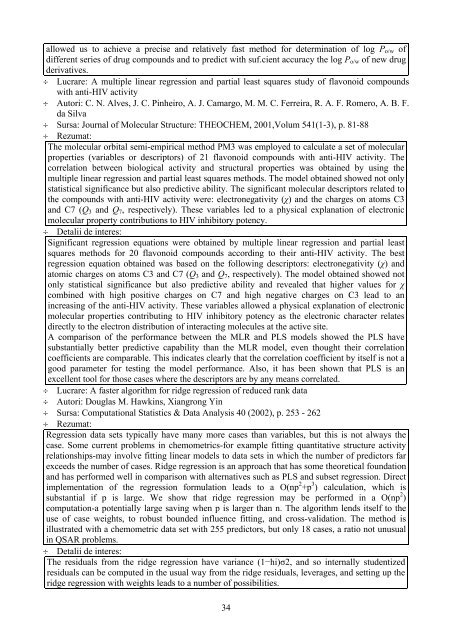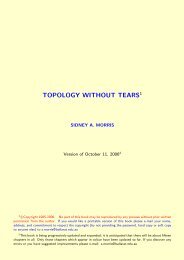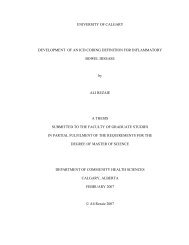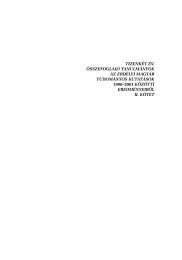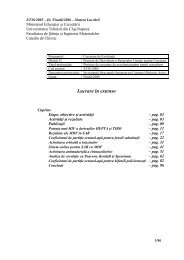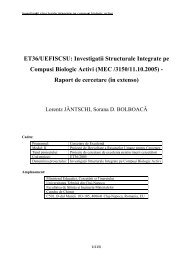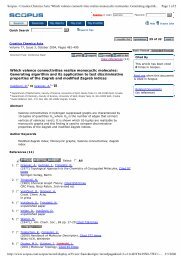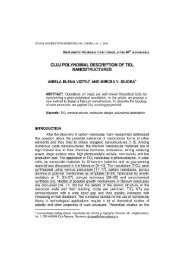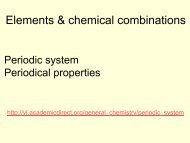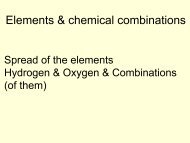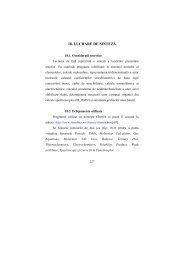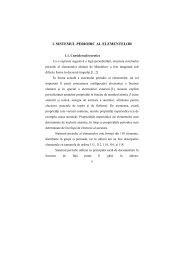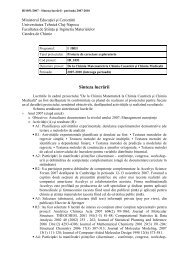Raport de cercetare - Lorentz JÄNTSCHI
Raport de cercetare - Lorentz JÄNTSCHI
Raport de cercetare - Lorentz JÄNTSCHI
You also want an ePaper? Increase the reach of your titles
YUMPU automatically turns print PDFs into web optimized ePapers that Google loves.
allowed us to achieve a precise and relatively fast method for <strong>de</strong>termination of log Po/w of<br />
different series of drug compounds and to predict with suf.cient accuracy the log Po/w of new drug<br />
<strong>de</strong>rivatives.<br />
÷ Lucrare: A multiple linear regression and partial least squares study of flavonoid compounds<br />
with anti-HIV activity<br />
÷ Autori: C. N. Alves, J. C. Pinheiro, A. J. Camargo, M. M. C. Ferreira, R. A. F. Romero, A. B. F.<br />
da Silva<br />
÷ Sursa: Journal of Molecular Structure: THEOCHEM, 2001,Volum 541(1-3), p. 81-88<br />
÷ Rezumat:<br />
The molecular orbital semi-empirical method PM3 was employed to calculate a set of molecular<br />
properties (variables or <strong>de</strong>scriptors) of 21 flavonoid compounds with anti-HIV activity. The<br />
correlation between biological activity and structural properties was obtained by using the<br />
multiple linear regression and partial least squares methods. The mo<strong>de</strong>l obtained showed not only<br />
statistical significance but also predictive ability. The significant molecular <strong>de</strong>scriptors related to<br />
the compounds with anti-HIV activity were: electronegativity (χ) and the charges on atoms C3<br />
and C7 (Q3 and Q7, respectively). These variables led to a physical explanation of electronic<br />
molecular property contributions to HIV inhibitory potency.<br />
÷ Detalii <strong>de</strong> interes:<br />
Significant regression equations were obtained by multiple linear regression and partial least<br />
squares methods for 20 flavonoid compounds according to their anti-HIV activity. The best<br />
regression equation obtained was based on the following <strong>de</strong>scriptors: electronegativity (χ) and<br />
atomic charges on atoms C3 and C7 (Q3 and Q7, respectively). The mo<strong>de</strong>l obtained showed not<br />
only statistical significance but also predictive ability and revealed that higher values for χ<br />
combined with high positive charges on C7 and high negative charges on C3 lead to an<br />
increasing of the anti-HIV activity. These variables allowed a physical explanation of electronic<br />
molecular properties contributing to HIV inhibitory potency as the electronic character relates<br />
directly to the electron distribution of interacting molecules at the active site.<br />
A comparison of the performance between the MLR and PLS mo<strong>de</strong>ls showed the PLS have<br />
substantially better predictive capability than the MLR mo<strong>de</strong>l, even thought their correlation<br />
coefficients are comparable. This indicates clearly that the correlation coefficient by itself is not a<br />
good parameter for testing the mo<strong>de</strong>l performance. Also, it has been shown that PLS is an<br />
excellent tool for those cases where the <strong>de</strong>scriptors are by any means correlated.<br />
÷ Lucrare: A faster algorithm for ridge regression of reduced rank data<br />
÷ Autori: Douglas M. Hawkins, Xiangrong Yin<br />
÷ Sursa: Computational Statistics & Data Analysis 40 (2002), p. 253 - 262<br />
÷ Rezumat:<br />
Regression data sets typically have many more cases than variables, but this is not always the<br />
case. Some current problems in chemometrics-for example fitting quantitative structure activity<br />
relationships-may involve fitting linear mo<strong>de</strong>ls to data sets in which the number of predictors far<br />
exceeds the number of cases. Ridge regression is an approach that has some theoretical foundation<br />
and has performed well in comparison with alternatives such as PLS and subset regression. Direct<br />
implementation of the regression formulation leads to a O(np 2 +p 3 ) calculation, which is<br />
substantial if p is large. We show that ridge regression may be performed in a O(np 2 )<br />
computation-a potentially large saving when p is larger than n. The algorithm lends itself to the<br />
use of case weights, to robust boun<strong>de</strong>d influence fitting, and cross-validation. The method is<br />
illustrated with a chemometric data set with 255 predictors, but only 18 cases, a ratio not unusual<br />
in QSAR problems.<br />
÷ Detalii <strong>de</strong> interes:<br />
The residuals from the ridge regression have variance (1−hi)σ2, and so internally stu<strong>de</strong>ntized<br />
residuals can be computed in the usual way from the ridge residuals, leverages, and setting up the<br />
ridge regression with weights leads to a number of possibilities.<br />
34


